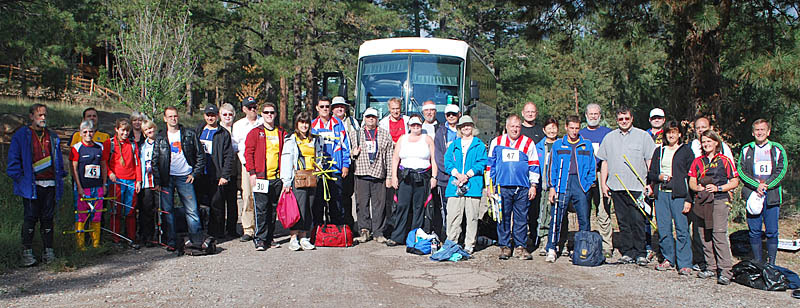
This group photo of competitors and some volunteers was taken just before the start of the two-meter event on Saturday, September 17.

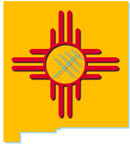
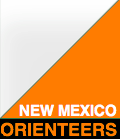 License plates in New Mexico proudly proclaim that it's the "Land of Enchantment." From September 14 through 18, it was the land of international-rules competitive RDF, also called foxhunting, foxtailing, radio-orienteering and ARDF. The 2011 USA ARDF Championships were combined with the biennial ARDF championships of International Amateur Radio Union (IARU) Region 2, which encompasses North and South America. Anyone from any state or country, with or without a ham license, was welcome to enter the championships by paying the registration fee and traveling to Albuquerque.
License plates in New Mexico proudly proclaim that it's the "Land of Enchantment." From September 14 through 18, it was the land of international-rules competitive RDF, also called foxhunting, foxtailing, radio-orienteering and ARDF. The 2011 USA ARDF Championships were combined with the biennial ARDF championships of International Amateur Radio Union (IARU) Region 2, which encompasses North and South America. Anyone from any state or country, with or without a ham license, was welcome to enter the championships by paying the registration fee and traveling to Albuquerque.
Albuquerque Amateur Radio Club (AARC) and New Mexico Orienteers (NMO) were the joint hosts. Their members arranged for housing, local transportation, hunt venues, maps, medals and the endless other details of a well run radiosporting event. Via ham radio magazines, newsletters, e-mail and the Web, we sought entrants from every part of the world and with every ARDF skill level, from beginner to expert. In the end, ten states from coast to coast were represented along with Canada, China, Germany and Ukraine. Although there was no formal teaming among the stateside hunters, some of them had trained together and put on local practice sessions for each other.
Prepare for a Monsoon
Late summer is "monsoon season" in New Mexico. Warm moist air masses come in from the south, are uplifted in the mountains and create thunderstorms almost every afternoon. Rains are occasionally heavy but are usually brief. The monsoons were welcomed in 2011 because the rains ended a threat of forest fires that had persisted through the spring and early summer.
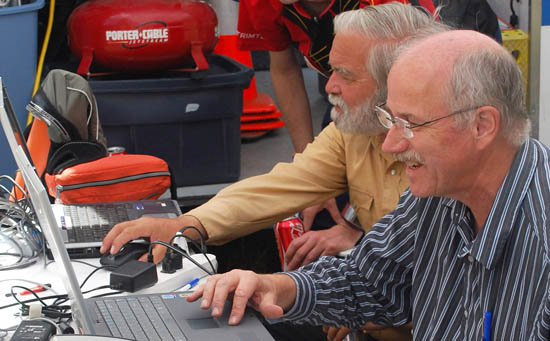 It has become a tradition for USA's championships to include an optional and informal "training camp" in the days just before the formal events get under way. The 2011 training was organized by Marvin Johnston KE6HTS of Santa Barbara, California and Jerry Boyd WB8WFK of Albuquerque. (In the photo at right, Jerry is closest to the camera and Marvin is sitting beside him.) On Wednesday and Thursday, September 14-15, trainees made their way to Oak Flat Picnic Area, 17 miles southeast of the city. This had been the site of the two-meter championship competition in 2005. The goal was to get a full-scale five-transmitter practice hunt completed each day before any rain set in.
It has become a tradition for USA's championships to include an optional and informal "training camp" in the days just before the formal events get under way. The 2011 training was organized by Marvin Johnston KE6HTS of Santa Barbara, California and Jerry Boyd WB8WFK of Albuquerque. (In the photo at right, Jerry is closest to the camera and Marvin is sitting beside him.) On Wednesday and Thursday, September 14-15, trainees made their way to Oak Flat Picnic Area, 17 miles southeast of the city. This had been the site of the two-meter championship competition in 2005. The goal was to get a full-scale five-transmitter practice hunt completed each day before any rain set in.
Eleven persons took to the woods in the training days. Keith Witney VE7MID came from Burnaby, BC Canada and the rest were hams from six states. Marvin, who operated the electronic scoring system for the training, also cooked up an after-hunt feast of Santa Barbara style tri-tip beef barbecue and all the fixings.
On Friday, about twenty additional foxtailers arrived for the formal competitions to follow on the weekend. After they registered at the event hotel and received their T-shirts, Jerry Boyd gave a PowerPoint presentation that thoroughly covered the IARU rules, logistics and dangers. Rules regarding GPS and other navigation aids were fully clarified. Competitors were expected to use only their maps, compasses and RDF gear for navigation. Although were allowed to take cell phones along for emergency communication, they were not to use any GPS features of the phone. All other GPS devices that have mapping screens were prohibited.
For competitive wilderness orienteering, an ordinary USGS topographical map isn't good enough. Orienteering maps must show the vegetation thickness and runability of the entire area, as well as details such as trails, fences, and rootstock. A standard format has been published by United States Orienteering Federation. Once it's all on paper, the entire area must be thoroughly field-checked against the map for accuracy. Jerry Boyd had spent many hours compiling maps and field checking maps for this event, with help from members of AARC and New Mexico Orienteering.
Bears, cougars and poisonous snakes had been reported within the competition sites, so everyone was told how to handle an encounter with any of them. A potentially greater danger was a shooting range within the two-meter competition area. Besides being marked as off-limits on the map, it was well fenced and signed.
The intense New Mexico sun at high altitude can cause severe sunburn and dehydration, so competitors were warned to use sunscreen and to carry water. They were also told what to do in case they got hurt or lost, to summon help from the New Mexico Search and Rescue Team.
The last order of business was the drawing of competitor "bib" numbers to determine who would be in each starting group on Saturday. On Sunday, the starting group order would be reversed. After that, all were invited to go outside and check their gear by finding test transmitters on two meters and 80 meters.
Where Are We Going?
For fairness, ARDF event organizers are encouraged to choose competition sites that have not been recently used for regular orienteering or radio-orienteering meets. This prevents anyone from having an advantage of familiarity with the venue and its terrain. It's best when the sites are kept secret so that advance reconnaissance cannot be done with existing orienteering maps, Google Earth and so forth.
AARC did a good job of keeping the sites a secret. They announced early on that large portions of the mountains surrounding Albuquerque were "embargoed." That meant that they were off-limits to anyone planning to participate in these championships. Anyone found to have visited these areas after the announcement would not be allowed to compete.
Besides site secrecy, there are three other reasons why ARDF championships in Albuquerque have always had bus transportation to the venues. It's important for everyone to arrive and depart at the same time, parking at the sites is quite limited, and buses would provide rapid evacuation of the area in case of a fire. Furthermore, the buses make transportation much easier for the foreign visitors. The modest increase in registration fees was offset in most cases by eliminating the need for out-of-area competitors to rent their own vehicles.
Buses boarded promptly after breakfast on Saturday to go to the two-meter hunt site. Competitors had speculated that it would be in the Sandia, San Pedro, or Sangre de Cristo Mountains, but instead the bus went north for about an hour to the outskirts of Santa Fe. Then it went north and west for another hour and entered the town of Los Alamos.
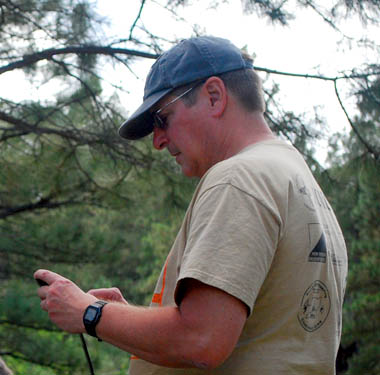 The mesas of Los Alamos were little known before 1942, when the US government took over the area as the secret site of the Manhattan Project. The National Laboratory is still the main employer in this close-knit community that has 12,000 souls and an above-average number of hams. The 48,000-acre Cerro Grande wildfire in 2000 destroyed 400 homes on the mesas and there was great concern that the Las Conchas fire that summer would do the same. Fortunately, the monsoons ended this fire after it burned only a small part of the area that had been mapped for this hunt.
The mesas of Los Alamos were little known before 1942, when the US government took over the area as the secret site of the Manhattan Project. The National Laboratory is still the main employer in this close-knit community that has 12,000 souls and an above-average number of hams. The 48,000-acre Cerro Grande wildfire in 2000 destroyed 400 homes on the mesas and there was great concern that the Las Conchas fire that summer would do the same. Fortunately, the monsoons ended this fire after it burned only a small part of the area that had been mapped for this hunt.
The bus went through downtown to the northernmost part of Los Alamos and onto Range Road, just past Guaje Pine Cemetery. There it stopped, next to a porta-potty that had been rented by the organizers for the occasion. Scott Stevenson KC5VVB (pictured at right) and a crew of volunteers from the Los Alamos Amateur Radio Club were waiting.
Competitors received their 11 X 17-inch full-color maps ten minutes before start time. Most mounted the map on cardboard or foam board and covered it with clear plastic so they could mark bearings on it. The German competitors preferred cork boards with pushpins. Hunters discovered that the start and finish were only 260 meters apart in the southwest corner of the map. Would the fox transmitters be to the north in Canyon West, to the east in Canyon East, or in both?
After hearing the starting tones, IARU Rules prohibit competitors from stopping to do RDF until they are at the end of the start corridor, out of sight of the hunters still waiting to start. Five minutes before start time, members of each group lined up at the starting line and gazed out into a corridor like none they had ever seen. Instead of the usual dirt path into the woods, it was a boulder-filled canyon. There was no need to mark it with tape as is usually done, because all knew that they would have to go to the end of this canyon and get away from its walls before they could get reliable RDF bearings.
The entire mapped area encompassed about 2650 acres of forest, with ponderosa pine, pinon, and alligator juniper. At 7200 feet, the altitude posed a formidable running challenge for many hunters. The mosquitoes weren't out in force, but the forest floor had boulders in many places, making it important for them to mind their footing. The optimum straight-line course length, from start to all five foxes and then to the finish, was just over seven kilometers.
Course-setter Jerry Boyd WB8WFK and the LAARC volunteer crew awaited the hunters as they ran through the ending corridor to the finish line. Cold drinks and box lunches were waiting for them. Standing by to treat any injuries or illnesses were April Moell WA6OPS and Joan Rogers KC5BPI. Also standing by at their homes for possible callout were members of New Mexico Search and Rescue. Fortunately, nobody got lost or stayed out in the woods more than five minutes beyond the three-hour time limit for the hunt on that day.
Medals and a Second Try
After the bus ride back to Albuquerque and a shower, everyone was ready for the awards banquet on Saturday evening at the hotel. Following the Mexican food buffet, medals were given to the top three two-meter places in each age/gender category. There were two sets of medals, one for competitors in IARU Region 2 (US and Canada only in attendance) and another set for visiting competitors from outside Region 2.
The fastest person to find all five two-meter transmitters on the course was Volodymyr Gniedov of Ukraine, who did it in one hour, twelve minutes and 28 seconds. USA's best included Vadim Afonkin KB1RLI of Boston, finding four required foxes in 1:24:52 in M40 and Jay Hennigan WB6RDV of Santa Barbara, who got his required three transmitters in 1:24:38. There were good results among stateside women including Ruth Bromer WB4QZG of Cary, North Carolina, who got her two required transmitters in 1:39:16.
Harley Leach KI7XF of Bozeman, Montana was the oldest competitor and was in a category by himself. Even though he was actually 69 at the time, Harley was in the new M70 category because "division age" is the age on December 31 of the competition year. Harley found his required 2 foxes and cruised to the finish and a gold medal in just an hour and two minutes.
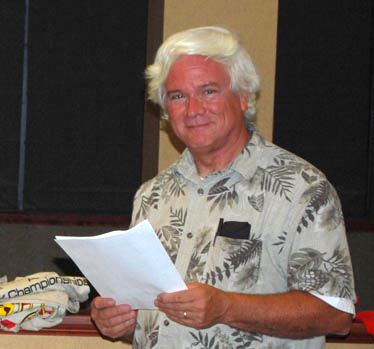 The bus trip on Sunday for the 80-meter hunt was much shorter, ending in a parking lot in Cienega Canyon, about 15 as-the-crow-flies miles northeast the hotel on the road to the Sandia Peak ski area. Then the bus stopped and the starting sequence began anew. But before that, there was a brief bus stop at the barricaded entrance to Sulphur Canyon, about 350 meters from the finish area.
The bus trip on Sunday for the 80-meter hunt was much shorter, ending in a parking lot in Cienega Canyon, about 15 as-the-crow-flies miles northeast the hotel on the road to the Sandia Peak ski area. Then the bus stopped and the starting sequence began anew. But before that, there was a brief bus stop at the barricaded entrance to Sulphur Canyon, about 350 meters from the finish area.
Just days before, Sulphur Canyon had been closed due to multiple bear sightings. Rangers had noticed that a certain berry, found in abundance in that canyon, was attracting them in unusually large numbers. Knowing this, the organizers gave participants a special map page showing the closure area and the detour that they would have to take to get to the finish line. Not only were they in danger if they went into Sulphur Canyon, but they risked a $10,000 fine if seen by a Forest Service official there.
As they picked up their 80m maps, all of the hunters were planning how to do better than the day before. This time the start and finish were about a kilometer apart in the north-central portion of the map. They could tell that the transmitters would have to be in the south and east areas of the 1400-acre venue to meet the exclusion zone requirements of IARU rules.
The signal reflections that can plague transmitter hunters on two meters in hilly and mountainous areas are non-existent with 80-meter groundwave propagation, so it is normal for competitor's times to be shorter on this band. The altitude was slightly higher, but the course was about 17 per cent shorter. Everything went smoothly for both the organizers and the hunters. Almost every performance was better.
As the competitors finished and downloaded their "e-sticks," the new FjwW scoring software kept everyone apprised of the competitor standings. Results were continuously broadcast via Wi-Fi at the finish area, available to anyone with a suitable device to view them.
A hearty "Well done!" and thank-you to AARC and its event leaders, as named above. Special kudos to Mike Pendley K5ATM (pictured above right), who was the primary contact for the hotel and for the buses. He also was emcee for the awards banquet. Thanks to the members of the radio clubs of Albuquerque and Los Alamos for their help. And thanks to everyone who attended for the interest, enthusiasm, and positive attitude that prevailed.
Click for five pages of photos in this Homing In site.
Additional details and photos are in my ARDF Update feature "New Mexico Hosts Successful Foxhunting Championships" on the ARRL Web site.
Portions of this report have been excerpted from my Homing In column in the Fall 2011 issue of CQ-VHF Magazine.
Joe Moell KØOV
ARRL ARDF Coordinator
Text and photos copyright © 2011 Joseph D. Moell. All rights reserved.
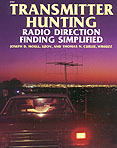 Go to First photo page of this event
Go to First photo page of this event
Go to Championships Foxhunting News -- Recent and upcoming ARDF championships events
Go to International-Style Foxhunting Comes To The Americas -- How we're getting the ball rolling
Go to Equipment Ideas for Radio-Orienteering -- Simple and inexpensive receiving and transmitting solutions
Go to Radio-Orienteering News for Southern California -- Results and stories of recent radio-orienteering events in southern California, plus announcements of upcoming ones.
Go to Foxhunting for Scouts -- Let's get the kids involved
 Back to the Homing In home page
Back to the Homing In home page
This page updated 20 April 2023